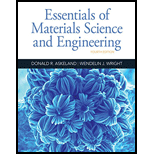
Interpretation:
The effect on toughness of alumina ceramic when SiC fiber having low toughness brittle ceramic is embedded within Alumina needs to be explained.
Concept introduction:
Alumina is brittle and has low toughness. Silicon carbide is a compound of carbon and silicon produced at very high temperature.
Answer to Problem 7.1P
When silicon carbide (sic) fibers are embedded within the alumina, its toughness improves due to the interface between fiber and alumina matrix.
Explanation of Solution
Ceramics materials are brittle in nature and have low tensile strength and toughness which makes them weaker.
There is a tendency of crack formation. When a tensile force is applied on ceramic material, cracks in the structure get elongated. When crack grows, energy gained by cracks increases and then gets absorbed by the material.
But when these ceramics are embedded with fibers like silicon carbide, the toughness of ceramic matrix increases.
Ceramic matrix composites are the materials in which ceramics are embedded with reinforcement these matrix having low toughness.
Also, if the bonding between matrix and fiber is sufficiently bad, the fibers are pulled out of matrix consuming energy.
The stress intensity factor, k is calculated as follows:
From the formula, stress intensity factor k is directly proportional to tensile strength. This means, if tensile stress increases, the value of k also increases.
Silicon carbide has a higher tensile strength than alumina. Hence if we embed the SiC with alumina, it will result in higher tensile strength.
Thus, toughness will increase with an increase in tensile strength.
Thus, it can be stated that silicon carbide embedded with alumina so as to increases the toughness of the alumina ceramic matrix.
Want to see more full solutions like this?
Chapter 7 Solutions
Essentials Of Materials Science And Engineering
- Draw the small-signal equivalent circuit of a single transistor amplifier given in figure B1b. Assume the current source to be ideal. Determine the Open-loop transfer function, pole frequency and gain-bandwidth product all in terms of transistor parameters 9m, To and CL. If the load capacitance is 1pF and the necessary unity gain frequency is 600MHz, find the gm for this transistor. V₁ V₁ CLarrow_forwardCORRECT ANSWER AND COMPLETE FBD ONLY. I PREFER HANDWRITTEN BUT ITS OKAY IF NOT. I WILL UPVOTE 3. The frame has pin supports at A and E, subject to a wind load. Treat joint C to be an internal hinge. Given:Dimensions, H1 = 3.0 m; H2 = 4.5 m; L = 10.0 mWind loads, wWL (AB) = 4.8 kN/m; wWL (BC) = 3.9 kN/m; wWL (CD) = 1.5 kN/m; wWL (DE) = 1.2 kN/mMembers are made of A36 steel Wide Flange Section with the following properties:Area, A = 64000 mm2Depth, d = 762 mmFlange width, bf = 371 mmThickness of web, tw = 32 mmThickness of flange, tf = 57.9 mmMoment of inertia about x-axis, Ix = 6080 x 106 mm4The wide flange is oriented so that the bending is about the x-axis1. Calculate the stress in member AB, due to the axial load it carries, indicate if tension or compression.Answer: 0.0476 MPa Tension2. Calculate the stress in member DE, due to the axial load it carries, indicate if tension or compression.Answer: 0.2351 MPa Compression3. Calculate the maximum bending stress at B. Answer: 4.282 MPaarrow_forward23baarrow_forward
- 23aaarrow_forwardGive me compression member problems in steel design, including calculation of slenderness ratio and critical stress using Euler formula, with complete solution and answer.arrow_forwardGive me flexural design problems of steel beams, including lateral-torsional buckling, and solve for nominal moment capacity, with step-by-step solution and answer.arrow_forward
 MATLAB: An Introduction with ApplicationsEngineeringISBN:9781119256830Author:Amos GilatPublisher:John Wiley & Sons Inc
MATLAB: An Introduction with ApplicationsEngineeringISBN:9781119256830Author:Amos GilatPublisher:John Wiley & Sons Inc Essentials Of Materials Science And EngineeringEngineeringISBN:9781337385497Author:WRIGHT, Wendelin J.Publisher:Cengage,
Essentials Of Materials Science And EngineeringEngineeringISBN:9781337385497Author:WRIGHT, Wendelin J.Publisher:Cengage, Industrial Motor ControlEngineeringISBN:9781133691808Author:Stephen HermanPublisher:Cengage Learning
Industrial Motor ControlEngineeringISBN:9781133691808Author:Stephen HermanPublisher:Cengage Learning Basics Of Engineering EconomyEngineeringISBN:9780073376356Author:Leland Blank, Anthony TarquinPublisher:MCGRAW-HILL HIGHER EDUCATION
Basics Of Engineering EconomyEngineeringISBN:9780073376356Author:Leland Blank, Anthony TarquinPublisher:MCGRAW-HILL HIGHER EDUCATION Structural Steel Design (6th Edition)EngineeringISBN:9780134589657Author:Jack C. McCormac, Stephen F. CsernakPublisher:PEARSON
Structural Steel Design (6th Edition)EngineeringISBN:9780134589657Author:Jack C. McCormac, Stephen F. CsernakPublisher:PEARSON Fundamentals of Materials Science and Engineering...EngineeringISBN:9781119175483Author:William D. Callister Jr., David G. RethwischPublisher:WILEY
Fundamentals of Materials Science and Engineering...EngineeringISBN:9781119175483Author:William D. Callister Jr., David G. RethwischPublisher:WILEY





